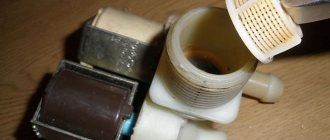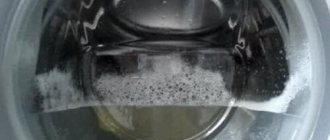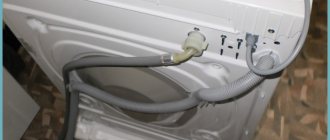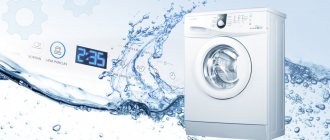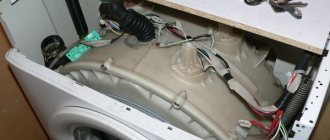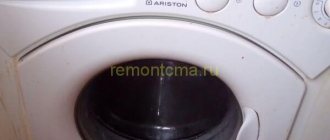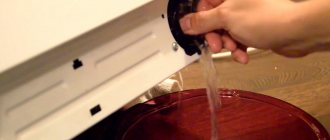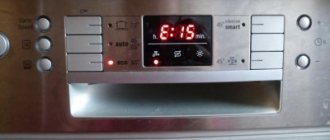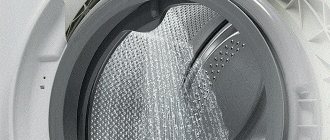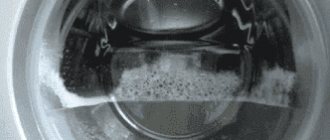What does this mean?
According to the instructions for the washing machine, its internal elements must be kept dry between washes. First of all, this applies to the drum where dirty things are loaded.
If the washing machine fills with water when it is turned off, this can lead to the following problems:
- the spread of an unpleasant odor in the room where the machine is installed;
- the formation of fungus and mold on the inner walls of the drum;
- gradual rusting of the metal elements of the device;
- danger of water pouring out of the washing machine onto the floor of the apartment.
Based on this, it is necessary to take this problem seriously and make every effort to eliminate it.
Why does the washing machine take up water on its own?
How did liquid appear in the disconnected equipment? There are two options - from the sewer or water supply. It is not difficult to determine this by color and smell. It’s good if you immediately discovered the problem, but it also happens that water enters the machine when the owner is at work. Then you can find a whole flood at home. Therefore, experts recommend closing the inlet valve after each wash.
The Aquastop system will not protect against leakage. The sensor is located in the tray, and the water flows directly into the drum, after which it is poured onto the floor.
What is the cause of the malfunction:
- the intake valve is broken;
- clogged or incorrectly connected drain.
Remember that the warranty does not apply in cases where the user independently connected the equipment to the water supply. You can use warranty services if the installation of communications was carried out by a master, after which a leak occurred.
Clearing the blockage
Most often, a disconnected machine is filled with liquid from the sewer when the hose is connected to the siphon. If clogged, the device does not function properly, allowing water to flow into the washer tank. Do this:
- Close the inlet valve.
- Disconnect the drain hose.
- Check the siphon and remove the blockage.
Debris can be removed manually or using special means. After this, run a short cycle with hot water to clean the drum and check the operation of the washer.
If the problem is not a blockage, then make sure the connection is correct. Inspect the communications and make sure the hose is positioned correctly. To prevent water from filling in and draining on its own, the end of the hose should be at a distance of 50 cm - 1 m from the floor. Then the pump will function normally and drive liquid into the sewer.
Replacing the solenoid valve
The inlet or solenoid valve is located immediately behind the water supply hose, at the top of the front machine. On top-loading models, the part may be located behind the side wall. When the equipment is off, the valve is closed. As soon as the washing machine starts, current flows to the valve contacts and the damper opens, letting water into the tank.
As soon as the current supply stops, the damper closes and washing begins. Often the valve operates as a characteristic click. If the element breaks, the damper does not operate at all. Then, even when turned off, the machine draws water.
What to do? First of all, close the inlet valve and turn off the power to the washing machine. Turn the equipment with its convenient side facing you. Next follow the instructions:
- Remove the two bolts from the back and remove the top cover from the housing.
- There are usually two hoses leading to the valve. In some SMA models, the part is covered with a powder cuvette.
- Unclench the clamps and disconnect the hoses.
- Disconnect the wiring.
- Unscrew the fastening bolts.
A broken element cannot be repaired. A multimeter will help you make sure it's working properly. Attach the tester probes to the valve contacts and look at the display. The working part will show a result of 3 kOhm.
Select a similar part and install in reverse order. Do not rush to replace the machine cover. Turn on the test cycle and check the operation of the part in action.
The video shows how to replace the valve:
How to avoid leaks?
Finding a puddle on the floor is unpleasant, especially when you have to pay for the repairs to your neighbors. To avoid such situations, do this:
- After each wash, close the inlet valve.
- Use an anti-siphon valve to prevent dirty liquid from entering the drum.
- Install full leakage protection. It includes sensors on the floor that will trigger if there is a leak.
Use proven methods so as not to repeat the mistakes of others. It is better to take care of safety in advance than to eliminate the consequences later.
Where does the water come from when the washing machine is turned off?
There are two sources from which water can get into the washing machine drum:
- Sewer system. It is quite easy to recognize such a liquid by its unpleasant odor and dirty appearance. This usually happens with units whose drain is connected to the siphon of a nearby sink.
- Water pipe. In this case, we are talking about clean water seeping through the inlet valve. To check, you need to turn off the tap on the supply hose: the flow of water into the drum should then stop.
What to do
Once you have determined where the water in the disabled washing machine came from, it’s time to move on to action to eliminate the problem. But what is the best thing to do: call a specialist or try to fix everything on your own?
- If water comes from the sewer, then the reason is either a blockage or an incorrect connection of the drain to the sewer. In principle, anyone can remove the blockage on their own. Getting the drain out correctly is a more difficult task. If you cannot cope with it on your own, then you can use the service of professional installation of washing machines.
- If water enters the washing machine due to a faulty inlet valve , you can, of course, try to replace it yourself. However, this is a very risky undertaking, especially if you are going to change the valve for the first time. Therefore, you should not experiment - it’s better to call a specialist. In the meantime, you are waiting for him to arrive, just turn off the water supply valve to the machine.
Important for those whose washing machine is under warranty!
You should be aware that the manufacturer's warranty does not cover problems caused by improper connection of the washing machine to the sewer. Therefore, in this case, there is no point in calling the warranty service center; they will refuse you free repairs.
Methods for troubleshooting
Having discovered that the switched off washing machine is drawing water, you must immediately close the supply tap. If this is not done, the liquid will eventually begin to pour out of the drum onto the floor. Actions to eliminate the malfunction depend on its nature.
Water comes from the sewer
The reason why wastewater gets inside the washing device is usually an error in the drainage system. Therefore, it is strongly recommended that you strictly follow the manufacturer’s recommendations when installing a household appliance.
Why does sewer water end up in the washing machine drum?
- Poor location of the drain hose . This applies to situations where the drain occurs directly into the bathtub or sink. It is necessary to ensure that the end of the elastic tube is located below the level of the drum and is not immersed in water.
- There is a blockage in the tube. In this case, the waste water simply cannot come out. All you need to do is clean the hose.
- The siphon to which the unit is connected is clogged. This will also be indicated by stagnation of water inside the sink. Washing the siphon is quite simple: the main thing is to carefully unscrew its flask.
To avoid a situation where, when the siphon is clogged, water from the sink begins to move into the washing machine drum, it is recommended to use a siphon valve. It is designed in such a way that it allows fluid to flow in only one direction (in this case, away from the car).
Water comes from the water supply
There is only one reason for this malfunction - failure of the water supply solenoid valve. This type of device cannot be repaired - it only needs to be changed.
Situations that can cause intake valve failure:
- The presence of a large amount of mechanical impurities in the water. The solution is to install dirt filters on the pipes.
- Valve wear. Like any other device, it has a service life.
- Faulty wiring inside the washing machine. A short circuit can cause spontaneous operation of the valve.
What to do to change the intake valve yourself:
- Disconnect the appliance and turn off the water supply.
- Rotate the machine so that direct access to the rear of the body is provided.
- Unscrew the supply hose and remove the top cover.
- Find the valve. It is usually installed immediately behind the supply tube.
- Dismantle the valve, disconnecting it from the tubes and wires.
- Install a new device by connecting all tubes and wiring to it in the correct polarity. To make the procedure easier, it is recommended to photograph the supply lines before dismantling the old valve.
There are several models of intake valves. To purchase the right model, the easiest way is to go to a specialized store along with the broken device.
Prevention and advice
- In order not to flood the bathroom, and along with it the neighbors’ apartment, you can install an additional tap at the “entrance” to the washing machine, with which you can turn off the water supply. As soon as the unit completes the washing process, close the tap. So, even if the fill valve breaks down, water will not flow into the tank.
- If you doubt that the fill valve is really faulty, you can make sure of this by checking it using special equipment. Remove the valve and connect the water supply hose to it. Make sure the valve is not leaking water. Then apply voltage to each section of the valve in turn. Water should flow from the section that is energized. If this does not happen, then the element is faulty.
- Another way to check the operation of the solenoid valve is to use a multimeter (a device that is used to diagnose electrical equipment). Attach the probes of the device to the metal plates on the valve, and switch the device to resistance measurement mode. If this indicator is in the range from 2 to 4 kOhm, then the valve is working.
You can get additional recommendations on connecting a washing machine to a water supply by watching the following video.
How to avoid trouble
To prevent situations when the washing machine draws water when it is turned off, it is recommended to perform several simple procedures:
- Screw in the shut-off valve after turning off the washing machine. Otherwise, pressure from tap water will constantly be applied to the inlet valve membrane. As a result, the service life of the device will be noticeably reduced. In cases where the supply hose is not equipped with a shut-off valve at all, this situation must be corrected immediately.
- Equip the siphon to which the drain hose is connected with a check valve. Thanks to this, the washing machine will receive additional protection against waste water entering its drum.
- Install a shut-off valve between the siphon and the drain hose. By closing it after finishing washing, you don’t have to worry about clogging or breaking the siphon. The main thing is not to forget to open the valve before turning it on.
- Install a special anti-leak system that reacts to the appearance of moisture on the floor of the room. The Aquastop function inside the washing machine will not help in a situation where water enters a de-energized appliance. The fact is that the sensors of the built-in system are located inside the pan of the machine, and water from an overfilled drum usually flows directly onto the floor.
Situations when a washing machine that is turned off takes in water are rare, but they do occur. In this case, there is no need to panic: the most you have to do is change the intake valve.
Looking for a reason
To understand why a turned off washing machine takes in water, the user needs to remember that water can come from a water supply or from a sewer. Agree, the second option is more unpleasant than the first. It is not difficult to understand exactly where the water comes into the drum. When pouring water from the sewer, a characteristic, disgusting odor will appear.
Water in the car
If water gets in from the water supply, there is no need to rely on the AquaStop system to operate. The sensor is placed in the tray of the device, and the water will flow out onto the floor. In any case, it is necessary to identify the cause and eliminate it. Experts say that the washing machine draws water when it is turned off due to the following reasons:
- Damage to the water supply valve.
- Missing or broken siphon valve.
- The drain system is clogged, causing water to not drain down the drain, but to flow back into the drum.
Call the master
This is interesting: Replacing brushes on an electric motor for a washing machine
